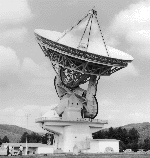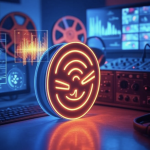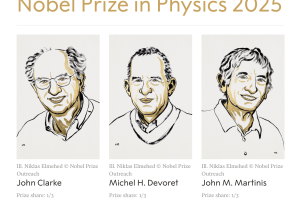Planets, stars and nebula’s all emit radio waves, which are a form of invisible light waves. They are detectable with radio telescopes such as the dish telescopes at Westerbork and radio telescope LOFAR. But how do the researchers at ASTRON construct an image out of those invisible waves?
By Mischa Brendel
Radio waves
Electromagnetic spectrum

All matter emits radio waves, but some matter does this at specific wavelengths. Hydrogen, for example, emits radio waves at 1420 MHz. Hydrogen also happens to be one of the most important building blocks in the universe. Stars are born from it. Therefore, measuring the amount of hydrogen in the universe teaches us a great deal about the formation of the universe. This makes radio waves one of the most invaluable resources for understanding our universe.
Radio waves are detectable with radio antennas. This can be done with the traditional dish antennas, like those at Westerbork. The 14 Westerbork parabolic dishes date back to the seventies, but are not as old as they seem: throughout the years the radio telescope has received several updates, of which the most recent in 2018. Each dish antenna carries at its center a receiver at which all the radio waves caught in the dish converge.
Westerbork Synthesis Radio Telescope (WSRT).
(Credit: ASTRON)
Radio waves can also be detected with telescopes like LOFAR, which operates in a different way. This radio telescope basically is a group of many telescopes spread out over several countries, in which each ‘telescope’ is a field full of radio antennas. The dish telescopes at Westerbork look at a single point in the universe simultaneously, a field full of LOFAR-antennas can look at multiple directions simultaneously.
With LOFAR each antenna is connected to its own receiver. Since the radio waves that are caught are very weak, radio telescopes have amplifiers to increase the signal strength. The signals measured are noise-like. However, the amplifiers themselves also add noise to the signal. So how to measure the proper signal and ignore the rest? This is where complicated calculations and computations come in, explains Dr Ir Albert-Jan Boonstra, programme manager technical research at ASTRON. “The signal coming from space has a specific characteristic, while each radio telescope causes its own, unique noise signal. So, the signal which each telescope receives that is identical to the signal received by other telescopes must be the signal from space. We filter out the other noise-like signals.”
Low Frequency Array (LOFAR), with the LOFAR core on the left and antennes for the low frequencies on the right. (Credit: ASTRON)

The radio waves also need to arrive at the receiver simultaneously. All time differences must be corrected for, because in order to receive a strong enough signal so that an object can be properly charted, the received radio waves need to be coherently added up. Again, computational power is key.
By constantly taking measurements the telescopes produce tremendous amounts of data: for LOFAR this adds up to petabytes of data per day. Boonstra: “Ideally we’d store and process all of those data, but we cannot afford to do so. Therefore, we add up the signals from the antennas on a single field and only send through those accumulated data. This reduces the amount of data a hundredfold.”
A central system then correlates the data, after which incorrect data are removed or corrected. Subsequently the data are calibrated. “Then it is up to the astronomers to make proper astronomic charts out of these data,” says Boonstra.
A central system then calibrates the data: incorrect data are removed and corrected. Subsequently the data are correlated, which results in a correlation matrix. “Then it is up to the astronomers to make proper
Radio waves can also be detected with telescopes like LOFAR, which operates in a different way. This radio telescope basically is a group of many telescopes spread out over several countries, in which each ‘telescope’ is a field full of radio antennas. The dish telescopes at Westerbork look at a single point in the universe simultaneously, a field full of LOFAR-antennas can look at multiple directions simultaneously.
With LOFAR each antenna is connected to its own receiver. Since the radio waves that are caught are very weak, radio telescopes have amplifiers to increase the signal strength. The signals measured are noise-like. However, the amplifiers themselves also add noise to the signal. So how to measure the proper signal and ignore the rest? This is where complicated calculations and computations come in, explains Dr Ir Albert-Jan Boonstra, programme manager technical research at ASTRON. “The signal coming from space has a specific characteristic, while each radio telescope causes its own, unique noise signal. So, the signal which each telescope receives that is identical to the signal received by other telescopes must be the signal from space. We filter out the other noise-like signals.”
Low Frequency Array (LOFAR), with the LOFAR core on the left and antennes for the low frequencies on the right. (Credit: ASTRON)
The radio waves also need to arrive at the receiver simultaneously. All time differences must be corrected for, because in order to receive a strong enough signal so that an object can be properly charted, the received radio waves need to be coherently added up. Again, computational power is key.
By constantly taking measurements the telescopes produce tremendous amounts of data: for LOFAR this adds up to petabytes of data per day. Boonstra: “Ideally we’d store and process all of those data, but we cannot afford to do so. Therefore, we add up the signals from the antennas on a single field and only send through those accumulated data. This reduces the amount of data a hundredfold.”
A central system then correlates the data, after which incorrect data are removed or corrected. Subsequently the data are calibrated. “Then it is up to the astronomers to make proper astronomic charts out of these data,” says Boonstra.
A central system then calibrates the data: incorrect data are removed and corrected. Subsequently the data are correlated, which results in a correlation matrix. “Then it is up to the astronomers to make proper
Try It At Home! Make a Radio Image!
Radio waves are emitted by planets in our solar system, chemicals in comets and in the Milky Way Galaxy, supernovae, and by other galaxies and distant quasars. These radio waves travel through space just like light, and radio telescopes can intercept them. Astronomers often convert these signals into pictures. Here are three “radio pictures” showing:
 |  |  |
| A supernova remnant | The moon | A galaxy |
They look like photographs don’t they? But radio waves are invisible! So, how do scientists make “radio pictures” of the objects in the Universe?
 Radio telescopes look like this. The dish of a radio telescope is made of metal and has a parabolic shape. The 140′ telescope, pictured here, is pointing at an object in the universe. Radio waves emitted by that object hit the surface of the dish, and bounce. Because the dish is shaped the way it is, those waves all bounce up to the tip of the telescope, the focal point. The radio waves are focused there. At the focal point, the radio waves enter a sensitive receiver. The receiver amplifies the waves and converts them into a signal that can be stored in a computer. Astronomers use computers to turn this information into pictures. If our eyes were designed to see radio waves instead of light, the picture is what we would see. How do they do that?
Radio telescopes look like this. The dish of a radio telescope is made of metal and has a parabolic shape. The 140′ telescope, pictured here, is pointing at an object in the universe. Radio waves emitted by that object hit the surface of the dish, and bounce. Because the dish is shaped the way it is, those waves all bounce up to the tip of the telescope, the focal point. The radio waves are focused there. At the focal point, the radio waves enter a sensitive receiver. The receiver amplifies the waves and converts them into a signal that can be stored in a computer. Astronomers use computers to turn this information into pictures. If our eyes were designed to see radio waves instead of light, the picture is what we would see. How do they do that?
Print out Data Sheet 1, or Data Sheet 2 and you can make a radio picture! Notice all the little squares? Let’s call each one of these squares a pixel. Each pixel stores information about the radio waves coming from a point in space. The pixel beside it stores information from the very next spot in space and so on. A radio telescope scans across an object and receives radio waves from each little spot in space around that object. Some spots may have stronger radio waves coming from them than others. This imformation is stored in pixels. The computer turns this information into numbers. For example, if radio waves are weak at a particular position, a small number would be recorded in the pixel. If no radio waves were coming from that spot, the computer would put a zero in that pixel.
Astronomers may spend hours or even days scanning an object in order to have all the information they need. It may take them weeks to process the data to put accurate numbers in all of the pixels. But once they have all the numbers, they are ready to make a picture. An astronomer will assign a color to each number.
Then, the computer replaces the numbers with colors, and a picture of the radio source results!
You try it! Just pick some nice colors and color by number. What kind of object do you have? Does it look like any of the ones shown above?















Add Comment